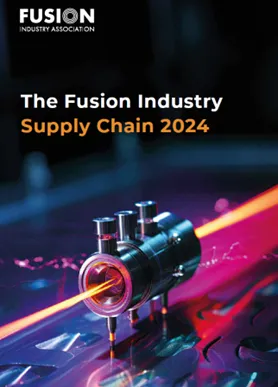The continued growth of the fusion supply chain – Insights from The Fusion Industry Association’s Supply Chain 2024 Report
By Naomi Scott-Mearns
The Fusion Industry Association (FIA) released their report The Fusion Industry Supply Chain 2024 on the 2nd July 2024. The report highlights large growth in the global fusion supply chain between 2023 and 2024, leading to more jobs, but it also warns of future supply risks of key fusion components and materials, as well as skilled people, which will need to be tackled to ensure continued progress in fusion and sustained expansion of the fusion supply chain.
The findings of the supply chain report were gained through the FIA surveying its members and affiliate members. FIA members are those developing fusion plants and affiliate FIA members are those companies developing the fusion supply chain.
The FIA first released their supply chain report in 2023 – you can read our analysis of that report here.
In this Insights Article, we cover 3 key insights from 2024 report as well as delving into the changes that have occurred in the past year.

The Fusion Industry Supply Chain 2024 report front cover. ©Fusion Industry Association
1. More is being spent in 2024 in the fusion supply chain
The key finding of the 2024 report is overall growth in the fusion supply chain. Respondents to the FIA’s survey for the report found that companies planned to spend an average of 21% more in the fusion supply chain in 2024, in comparison to 2023.
Spending more may lead to increased competition between private sector companies which the FIA report recognises is important for “driving forward innovation” (p5) in the fusion industry. Yet, the FIA also states the importance of collaboration, as well as competition, to solve problems and drive the industry in the direction required to enable successful commercial fusion.
The 2024 supply chain report says: “Whilst private sector competition is key to driving forward innovation, it is also clear that large-scale collaboration efforts are crucial along the supply chain, and on shared problems and supply constraints. The fusion industry is building an entirely new energy industry, and it will take coordinated work between governments, fusion companies, investors, the supply chain, and industry bodies like the FIA to deliver.” (p5)
2. The ‘chicken and egg’ supply scenario continues
In the 2023 FIA supply chain report, a chicken and egg scenario was identified, which was seen as a threat to future scaling of fusion technologies: “To ensure fusion can scale, it will need suppliers to start building capacity and capability now. But suppliers and their investors are uncertain of when fusion will be ready. So, which comes first: the chicken (industry), or the egg (the supply chain)?” (p5).
In the 2024 supply chain report, the chicken and egg scenario continues.
Companies within the fusion supply chain are reluctant to expand and build capacity without the security of “long term purchasing commitments” (p4) from fusion companies or governments. Lack of transparent spending commitments over two or more years by fusion companies means that supply chain companies cannot expand to build the capacity that fusion companies will demand once they start construction of commercial plants, or even demonstration models.
Capacity building in the future to scale-up supply to meet demand could take one to three years or longer. Therefore, the FIA recommends that other capital must step in to provide security of income for supply chain companies and to encourage supply chain capacity building: “investors and/or governments will need to provide some security to enable this accelerated rate of expansion.” (p16)
3. The workforce for fusion needs investment
The lack of availability of skilled people to work in the fusion industry was a key finding of the 2024 fusion supply chain report. Fusion companies are demanding skilled labour in order to fuel their growth. To solve this issue, “Governments, universities, and companies need to invest in strategic workforce development initiatives” (p17).
Earlier in 2024, we wrote about what the UK is doing to make its workforce fusion ready and invest in the skills growth which is required to realise commercial fusion (Fusion Skills – Equipping the Workforce for Commercial Fusion). The UK needs more skilled workers for fusion, but with dedicated outreach work, education and tailored training opportunities this could be realised.
Overall, what actions are required to facilitate growth of the fusion industry and its supply chain?
While the 2024 report shows that the fusion supply chain has grown and continues to grow, support is needed to ensure this is sustained. Support is needed in these main areas:
- Support to enhance collaboration between fusion companies and their supply chains for problem-solving of common issues. Industry trade bodies could fill this role.
- Long-term financial support from governments and industry bodies to enable fusion supply chain companies to increase their supply capacity.
- Educational and strategic support to upskill the workforce to have fusion-relevant skills, as well as promote the fusion industry as an aspirational industry to work in.
You can download the FIA 2024 supply chain report here.
